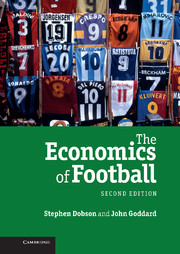Book contents
- Frontmatter
- Contents
- Preface
- Acknowledgements
- List of figures
- List of tables
- 1 Introduction
- 2 The economic theory of professional sports leagues
- 3 Competitive balance, uncertainty of outcome and home-field advantage
- 4 Forecasting models for football match results
- 5 Game theory and football games
- 6 English professional football: historical development and commercial structure
- 7 Determinants of professional footballers' salaries
- 8 Professional footballers: employment patterns and racial discrimination
- 9 The football manager
- 10 The football referee
- 11 Spectator demand for football
- 12 Gambling on football
- 13 Football around the world: France, Germany, Brazil, Japan and China
- 14 The economics of the World Cup
- References
- Index
3 - Competitive balance, uncertainty of outcome and home-field advantage
Published online by Cambridge University Press: 05 June 2012
- Frontmatter
- Contents
- Preface
- Acknowledgements
- List of figures
- List of tables
- 1 Introduction
- 2 The economic theory of professional sports leagues
- 3 Competitive balance, uncertainty of outcome and home-field advantage
- 4 Forecasting models for football match results
- 5 Game theory and football games
- 6 English professional football: historical development and commercial structure
- 7 Determinants of professional footballers' salaries
- 8 Professional footballers: employment patterns and racial discrimination
- 9 The football manager
- 10 The football referee
- 11 Spectator demand for football
- 12 Gambling on football
- 13 Football around the world: France, Germany, Brazil, Japan and China
- 14 The economics of the World Cup
- References
- Index
Summary
Introduction
The theoretical models of the economics of sports leagues reviewed in Chapter 2 are concerned with the degree of competitive balance or competitive inequality between the member teams of a league competition, which in turn determines the extent of uncertainty of outcome for individual match results and for the destination of the league championship. In Chapter 3, the emphasis shifts away from this theoretical analysis at the level of the league championship, towards the measurement and empirical investigation of competitive inequality and uncertainty of outcome for individual match results in football.
The measurement of competitive balance or competitive inequality in a sports league has been the subject of a large number of articles in the academic sports economics literature in recent years. Section 3.1 reviews this literature, with particular emphasis on studies focusing on English or European football. Section 3.2 examines the nature of home-field advantage in professional team sports. Section 3.3 investigates the statistical properties of football match results data, and examines the accuracy with which several variants of the Poisson distribution and the negative binomial distribution are able to describe the distributional properties of match results data presented in scores format. Finally, Section 3.4 presents an empirical investigation of persistence in sequences of consecutive match results. Does a winning streak help build a team's confidence, making it more likely that further matches will also be won? Or does it lead to complacency, increasing the likelihood that the next match will be drawn or lost?
- Type
- Chapter
- Information
- The Economics of Football , pp. 42 - 78Publisher: Cambridge University PressPrint publication year: 2011

